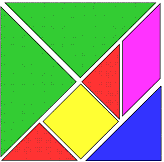Copyright © University of Cambridge. All rights reserved.
'Tangrams' printed from https://nrich.maths.org/
Show menu
Why do this problem?
Not only will children be using their knowledge of properties of squares as they try this activity, but they will also be putting into practice their visualising skills. Tangrams can be great to work on in pairs and this will encourage the pupils to talk together about what they are doing - a great opportunity for you to listen!
Possible approach
You could display the interactivity on the board and start by asking children to look at the image on the left (of the tangram pieces). Invite them to consider what they see and what they might like to ask. Give them time to think on their own, then talk to a partner about their 'noticings'. Encourage some pairs to share their observations and questions with the whole group. Try to take a step back and allow the class to respond to the comments and questions themselves, rather than you validating all contributions. Some children might talk about the different shapes they can see (and colours), some might describe the outline shape of the square. Build on their thoughts to introduce the idea of a tangram.
You can then set the class off in pairs on the challenges. After some time, invite them to offer 'hints' for the rest of the group, without giving away a solution. Perhaps they can offer advice about what they are finding helpful to focus on as they tackle the challenges, perhaps they can suggest a starting point for one of the squares... These challenges are not straightforward and learners are likely to get stuck. Talk about this with the class. How does it feel to be stuck? How are they trying to get unstuck? How does it feel when they make a breakthrough? You can stop the class as appropriate to share experiences.
The completed squares could make a lovely classroom display, accompanied by some brief notes written by the class, focusing on how they went about finding solutions.
Key questions
How many pieces have you got altogether?
What could you put with this piece to make a square?
Are all the pieces different?
What's the smallest square you can make?
Possible extension
To find more tangrams on the site (many of which have interactivities), enter 'tangram' in the top right-hand search box. Our interactive Tangram Browser contains a whole collection of tangrams.
Possible support
You may have to encourage some children to experiment and 'have a go'.
